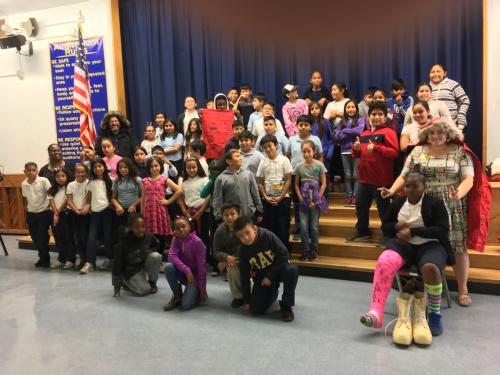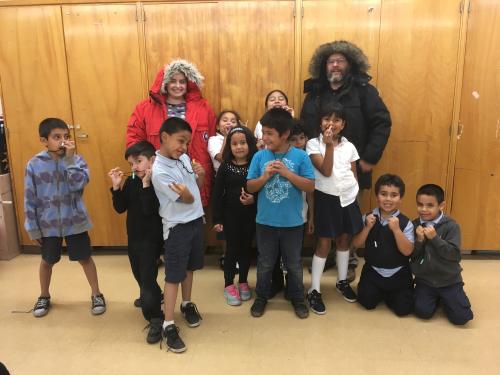 Polar Outreach selfie. Photo by DJ Kast
Polar Outreach selfie. Photo by DJ Kast
Students were worried about the snow melting, but one student looked at the tube of white stuff, and, with a smile on her face, said, "I'll keep it in the freezer forever." On November 17th and 18th, 1100 students at five Los Angeles schools learned about Arctic research science at polar assemblies.
 Dr. Byron Crump and I posing in front of our presentation. Photo by DJ Kast
Dr. Byron Crump and I posing in front of our presentation. Photo by DJ Kast
The National Science Foundation PolarTREC (Teachers & Researchers Exploring and Collaborating) program funded Polar Scientist Dr. Byron Crump's flight from Oregon State University facilitating the outreach with Polar Educator Dieuwertje Kast to five LAUSD schools participating in University of Southern California’s Joint Educational Project’s Young Scientists Program (YSP): 32nd St. School, Vermont Elementary, Norwood Elementary, Foshay Learning Center, and Weemes Elementary.
 Foshay Polar Assembly. Photo by DJ Kast
Foshay Polar Assembly. Photo by DJ Kast
 Vermont#1- Photo by DJ Kast
Vermont#1- Photo by DJ Kast
 Vermont #2. Photo by DJ Kast
Vermont #2. Photo by DJ Kast
 Vermont#3. Photo by DJ Kast
Vermont#3. Photo by DJ Kast
 Weemes Presentation. Photo by DJ Kast
Weemes Presentation. Photo by DJ Kast
Fourth grade teacher at Vermont Ms. Elsa Campos said, “the polar assembly provided the students with an opportunity to have a real vision of how scientists use research and experiments to learn and acquire knowledge.”
 Vermont#4. Photo by DJ Kast
Vermont#4. Photo by DJ Kast
Dr. Crump’s research focuses on microbial ecology of the Arctic tundra ecosystem. His results will help understand the Polar Regions by quantifying the impact of microbial ecology on the Arctic tundra, specifically the permafrost. Permafrost is permanently frozen soil or rock that remains at 0°C for at least two years. The permafrost represents a freezer filled with food for microbes, and as the temperatures get warmer this food starts the thaw. The microbes love the thawed food; they consume it and then breathe out CO2 (just like us humans and other animals). Microbes are perpetrators of climate change in the Arctic. They convert soil carbon into CO2 but different microbes do that job in different habitats. Microbial communities in lakes, streams, and soils are made up of very different species, and those species can be identified like a fingerprint. These fingerprints are defined by DNA sequencing. These habitats (soil, stream and lake) are connected, and Dr. Crump’s team is trying to see how these communities interact as different species wash down watersheds from soils to streams to lakes to the ocean.
 Mr. Abelson holding his Arctic flag. Photo by DJ Kast
Mr. Abelson holding his Arctic flag. Photo by DJ Kast
Ms. Kisha Maxie, fourth grade teacher at 32nd St school said, “the presentation was awesome! It gave the students a better understanding about the North Pole and South Pole. The misconception of all poles being snow covered was dispelled. I think that the kids especially liked when you passed around your gear and were to feel how heavy everything was. The part about the mosquitoes was also very interesting! Wow, the things that [they] endured for the sake of science! We appreciate [their] dedication and passion to the field. Thanks for a wonderful presentation.”
 Rahbyn holding Polar boots! Photo by DJ Kast
Rahbyn holding Polar boots! Photo by DJ Kast
Dr. Crump and DJ Kast also spoke to 11 K-3 students in the USC Wonderkids Program at Vermont Elementary with Coordinator Vanessa Arteaga and Assistant Coordinator So Dam Park!
 Wonderkids ASP group at Vermont Elementary. Photo by DJ Kast
Wonderkids ASP group at Vermont Elementary. Photo by DJ Kast
 Wonderkids student with Dr. Byron Crump. Photo by DJ Kast
Wonderkids student with Dr. Byron Crump. Photo by DJ Kast
Each of the students was given a microfuge tube with instant snow so that everyone could take home a little bit of “Arctic snow”.
 Ms. Kim and Mr. Carrillo receiving their Arctic flags from Dr. Byron Crump and Educator DJ Kast. Photo by DJ Kast
Ms. Kim and Mr. Carrillo receiving their Arctic flags from Dr. Byron Crump and Educator DJ Kast. Photo by DJ Kast
Ms. Trista Bernato, fifth grade teacher at Norwood Elementary said, “the polar assembly was informative and engaging. DJ is always a delight! My students were thrilled to see where their flags had been on her adventure and to have them returned to them, so that they can proudly display them. They had many questions concerning the carbon dioxide graph and it made them question what they could do to lower the amount in our environment. The YSP program has inspired many of my students to contemplate a career in the sciences. They especially loved the little bit of the Arctic DJ brought them in the form of instant snow.”
 Mr. Hinkel and some of his students posing with their Arctic flag! Photo by DJ Kast
Mr. Hinkel and some of his students posing with their Arctic flag! Photo by DJ Kast
Ms. Krystal Kim, fifth grade teacher at 32nd St School said "what a special treat for our kids to have a presentation by two amazing scientists! My students couldn't stop talking about the North Pole and especially their awesome snow souvenirs!"
 Diego holding his Arctic snow souviner. Photo by DJ Kast
Diego holding his Arctic snow souviner. Photo by DJ Kast
